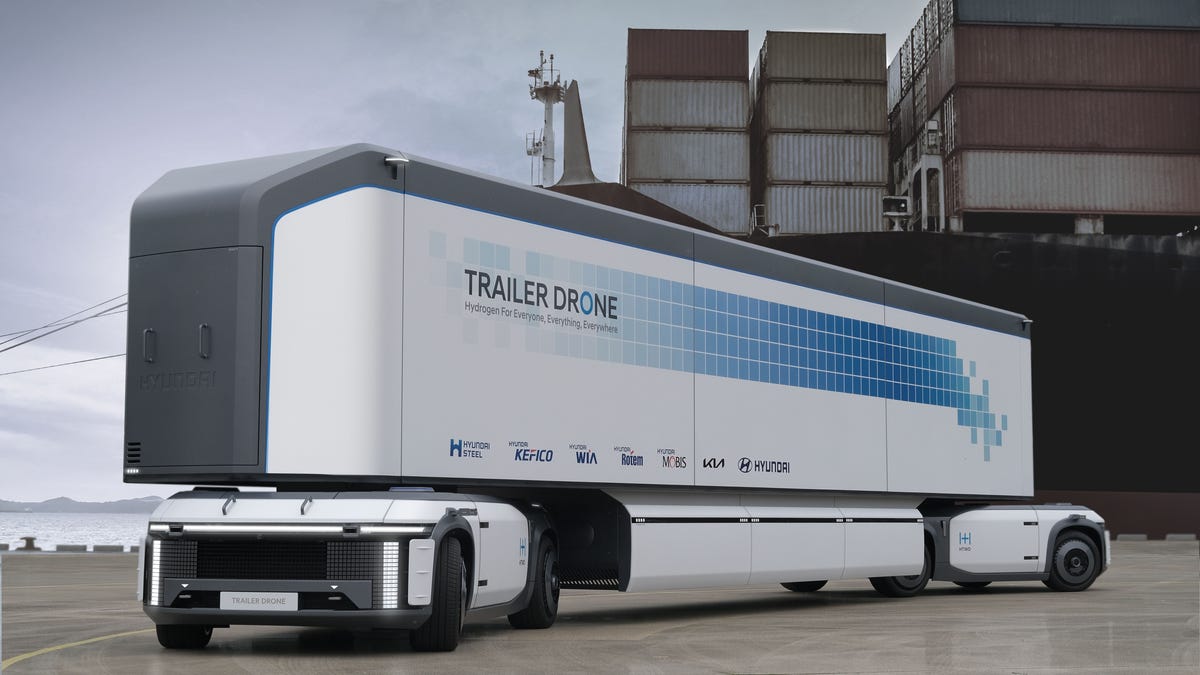Hyundai's Fuel Cell Trailer Drone is the future of trucking, minus the trucks
Hyundai's autonomous e-Bogie concept is a crazy zero-emissions robot that could transform the way we ship overland cargo.
Perhaps the most radical hydrogen-powered concepts to come out of the Hyundai Motor Group's Hydrogen Wave forum this week are this Trailer Drone concept and the modular Fuel Cell e-Bogie concept that it sits upon. Together, these vehicles imagine that zero-emissions hydrogen fuel cells and autonomous driving tech will combine to change the way we think of trucking and logistics -- and it all starts with ditching most of the truck itself.
The e-Bogie takes its name and inspiration from bogies, the two-axle subframes that a train car rides atop at either end. More "shipping robot" than truck, the e-Bogie is essentially an autonomous electric chassis powered by a hydrogen fuel cell. The e-Bogie can pull off impressive maneuvers like turning in place and diagonal "crab walk" driving thanks to its four-wheel independent steering. Its beefy, low-profile design allows it to carry a small shipping container or other load.
Hyundai's e-Bogies can be operated independently or combined to make larger Trailer Drones.
Things get interesting when multiple e-Bogies work together in Cluster Mode. Place a pair of e-Bogies on a full-size semi trailer, one at each end, and you have what Hyundai calls a Trailer Drone -- an autonomous trailer that can pilot itself around shipping yards, on highways and even in urban centers. Thanks to the dual independent steering at both ends, Hyundai envisions that large trailers can be expertly navigated around tight bends and small roundabouts with ease.
With four-wheel steering at both ends, the Trailer Drone concept can navigate surprisingly tight situations.
Mechanically, either e-Bogie can be the front or rear of the Trailer Drone, but the trailer itself houses some of the sensors to aid in highway autonomous driving, with the front and trailing panels aiding high-speed aerodynamics. Additionally, Hyundai imagines that these drones will be able to platoon on the highway, clustered close together for even better aerodynamics and long-haul efficiency. Hyundai estimates these vehicles as being capable of over 621 miles (1,000 km) per H2 fill-up. Upon arrival, the trailer can autonomously unload itself by lifting onto deployable legs and letting the underlying e-Bogies just drive away. They can even split into three smaller containers, each able to be carried by an independent e-Bogie to its final destination.
Outfit an e-Bogie with emergency service gear and you have the hydrogen-powered, autonomous Rescue Drone concept.
The e-Bogie vehicle platform could even be useful outside of shipping and logistics. Hyundai also showcased a Rescue Drone concept that outfits a single Fuel Cell e-Bogie with emergency service equipment. The concept could be deployed autonomously into dangerous firefighting or disaster relief situations or remotely operated by responders monitoring the video feed of an aerial drone charged and stored atop the Rescue Drone platform. Hyundai says there's even room between the drone's wheels for an internal compartment where more equipment or a pair of stretchers for evacuating injured persons could be located.
It's not immediately clear how close to production these vehicles are. These fuel-cell-based e-Bogie concepts are just one example of the Hyundai Motor Group's Vision 2040 goal of popularizing hydrogen as the renewable fuel of the future, a move that the South Korean company's home government is particularly keen on supporting. As part of its Hydrogen Wave forum this week, Hyundai also debuted a pair of hydrogen-powered heavy-duty service vehicles and the Vision FK concept, a fuel-cell plug-in hybrid sports car.


